CEO John Smith Steers FedEx Freight Toward E-Commerce Growth
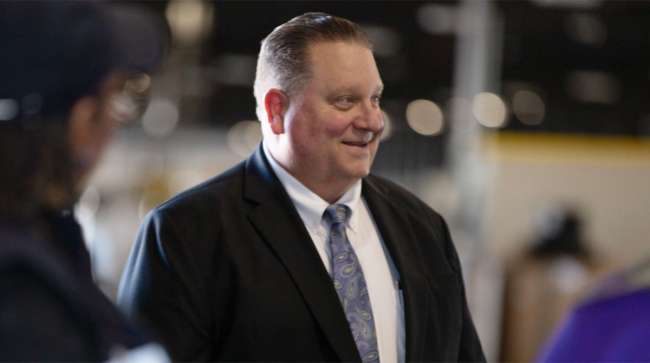
[Stay on top of transportation news: Get TTNews in your inbox.]
John Smith got into the trucking business early and never left, but it wasn’t the industry he planned to enter. He had intended to go into the oil business after college graduation, but an economic downturn and a misunderstanding about a job interview set him on a career path that led through a variety of leadership positions in trucking, and, just more than a year ago, to the CEO post at FedEx Freight.
He is guiding the company at a transformative time in trucking, as surging growth in e-commerce is compelling many carriers to take a hard look at their operations and seek ways to capitalize on the boom. FedEx Freight is no different.

Accelerators is Transport Topics’ new Q&A series with innovative leaders in trucking. In this, the second installment, FedEx Freight CEO John Smith discusses how he found his way to the trucking industry and what effects the rapid growth of e-commerce have on his LTL fleet and the trucking industry at large.
FedEx Freight is a division of Memphis, Tenn.-based FedEx Corp., which ranks No. 2 on the Transport Topics Top 100 For-Hire Carriers list.
During a recent interview with Transport Topics reporters and editors, Smith discussed the company’s plans to evolve its operations to capitalize on this opportunity, including details about what types of equipment — and types of freight — it sees as vital to its success.
He also discussed that job interview.
Q: How did you get into the trucking industry?
A: I’ll tell you a funny story. I majored in geology at a school in Louisiana called Northwestern State University. When I went into the geology program in the fall of 1980, the oil business was booming. In about 1982, we hit a big recession that lasted until about 1989. So, I coached football as a graduate assistant for a semester after I graduated, and then got an interview opportunity with this company called Roadway. I thought it was the Rodeway Inn, but it was Roadway the trucking company. My plan was to work for anybody until the oil business came back. It didn’t work out that way. That’s how I got into this business, and I’ve been in it ever since.
Q: What made you stay in the trucking business and not go back to the oil industry?
A: After about three years, the trucking business had its hooks in me. I liked it so much I couldn’t leave.
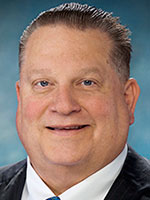
Smith
Meet John Smith
• Joined FedEx: 2000
• Previous position: Senior vice president of operations for FedEx Freight
• Industry involvement: Serves on Strategic Management Committee of FedEx Corp.; Sits on boards of American Transportation Research Institute and Arkansas Trucking Association
• Education: Degree in geology from Northwestern State University
Q: Did you ever drive a truck?
A: When you went to work for Roadway you had to have a CDL. I drove a log truck and different things on the farm when I grew up, but we had to work the dock and do all kinds of different things in their training program. I drove a truck a little bit, but I let my CDL go back in 1995.
When I went to work for Roadway, they had one of the best leadership training programs. I didn’t know that at the time, but I do now. Once you got done with the training program, you had to go to Akron to their corporate office and take a test. If you didn’t get an 80 or above on that test they fired you. It was an interesting time.
So, I went through there and started out on the dock as an outbound supervisor. When I left Roadway, I was running the hub out in Phoenix.
When I was about 34, I went to work for a company called Watkins Motor Lines, and then we were bought by FedEx in 2006.
Q: What was your first position at FedEx?
A: When they acquired us, I was a regional vice president for Watkins Motor Lines. When they bought us, they put me over transportation and safety for what we call FedEx Freight National. I was the VP of operations when we merged the companies together.
Q: Are you enjoying your job?
A: Absolutely.
Q: You’re leading FedEx Freight at an interesting time. The company’s pilot service for delivery of bulky items to consumers has expanded to 19 cities, recently adding Memphis and Nashville. There is growing demand for that kind of service. What kind of growth do you foresee for that segment?
A: Over the last 10 years, we’ve all seen the e-commerce business just explode. For a long time — specifically for FedEx Freight — we basically stayed away from that. Three or four years ago, we knew we would have to eventually address that growing industry. The heavy, hard-to-handle segment — as well call it — is over a $10 billion industry right now, and growing at double-digit margins. In the foreseeable future, we do not see that ending.
We’ve been running a pilot and are close to preparing to launch what we’re going to call FedEx Freight Direct. We’re going to take a rifle approach to that $10 billion market. We’ve got a real good business plan developed in order to take advantage of that market, and to offer a service that really differentiates us from the existing market. We’re really excited about entering this piece of the e-commerce business in freight.
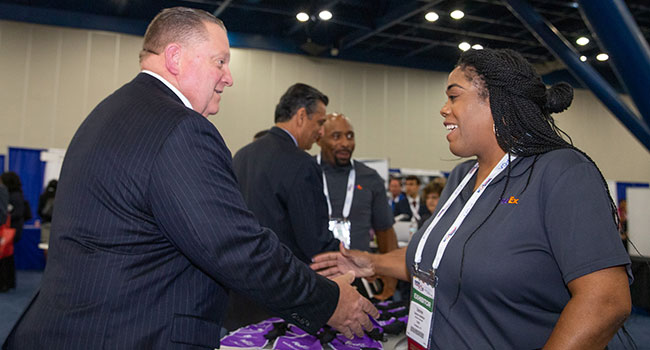
Smith greets a career fair attendee at the National Black MBA Association annual conference in Houston in September. (FedEx Freight)
Q: Why do you think people are more comfortable with going online to order heavier things such as refrigerators or furniture? What cultural change has occurred in the past five or seven years to make this so?
A: I think that’s just the evolution of e-commerce and the digital market. Everyone wants to do everything from their phone. It used to be smaller items they would order online that would be delivered directly to the house. Now, more and more, they’re feeling more comfortable ordering anything that you can order and having it delivered. And it’s not just in the freight business. It is happening with food, groceries — just about everything else. Household items can now be ordered and delivered to your home without you ever leaving. We feel like that’s going to continue, and that’s why we feel like we need to get into this business.
Q: Do you see a challenge at the very end — not the final mile, but the final inch? Is there a limit on weight? Do you see a point where you get into assembly?
A: Non-hookup is the first part of the business that we’ll be going into. As far as a weight limit goes, we will have liftgates on all of our equipment and, when needed, will make a two-person delivery. There is not a true weight limit as long as we can safely handle it with our liftgate.
Q: What is a non-hookup type of product, and who are the customers?
A: There’s a lot of folks that buy TVs that, instead of having it left on the porch, they want it brought into the first room available or the room of choice. There is furniture that is crated and packaged very well, that people will unpack and put together themselves. Workout equipment is the same way; instead of leaving it on their porch they want it brought inside. That’s the type of business that we’re going to go after.
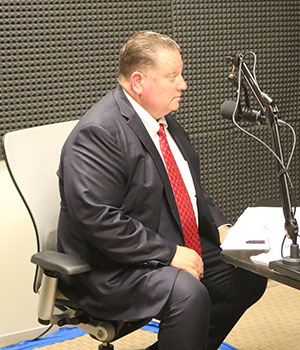
Smith sat in for an interview on Transport Topics Radio during a visit to Arlington, Va., in August. (Joe Howard/Transport Topics)
Q: That’s compared with something like a gas dryer, where there’s some assembly required.
A: Look at dishwashers, refrigerators — anything that needs to be hooked up. The complexity of getting certified to do that — not only by state but by county and city — it’s just mind-boggling. There’s enough business out there to go after where we don’t need to require that.
Q: What are some of your short- and long-term goals?
A: Right now, FedEx Freight averages about 109,000-110,000 shipments a day. When you look at this space that these shipments take up, it requires a lot of capital investment in equipment, as well as drivers and time. It’s hard to put an average daily shipment number that we’re going after, due to the fact that we want to grow this and grow it profitably. There is business to go after right now, and the amount and how quick we grow will depend on how well our model works. And we think we’ve got the right model.
Q: Is there a price point on these types of heavy shipments?
A: We are going to partner with well-known companies that need this service. Just like we are today, we want to be an extension of our customers. That’s the big part that’s missing in this industry — this piece of the e-commerce space. It’s going to be with the right companies — with the right type of business that we can be successful with.
We’ve been working on this for a couple years and feel like — with everything we’ve tested — that we’ve come up with the right model.
Remember, it’s all about the customer, and we’ve done our research. What do they need? What makes that experience the best? What would you pay for? What differentiates that from you going to the store to pick it up?
The No. 1 thing that’s important to them goes back to that hand-held device — the information on that shipment. That’s one of the things we’ve made sure is right before we roll this service out. We wanted to make sure from a technological perspective that we will be differentiated in the marketplace, because that information is critical — being able to hit those appointment windows, and the timing. When you have a network that is built for speed, like we have today, we feel like we can take advantage of the existing network and put out a superior product.
Q: E-commerce is only going to get bigger. What effect will that have for the company as a whole?
A: A lot of the big companies are building warehouses where the population is. We’re still going to be hauling business-to-business, but it’s probably going to shorten the length of the haul for a lot of these larger companies due to the fact that they’re going to build out their warehouse footprint.
We also feel that retailers have a huge opportunity to use stores that exist today. You saw the results from some retailers in this last quarter, where they’ve shifted the ability to utilize these front stores as e-commerce centers. A lot of companies have been able to do this. You’ve got to [deliver] those goods and products; whether it’s going to their warehouses or their stores, that will still be a business-to-business transaction. We’ve been very nimble and adjusted to those changes. We feel good about that part as well as the opportunity that we have in this new e-commerce space that we have not played in before.
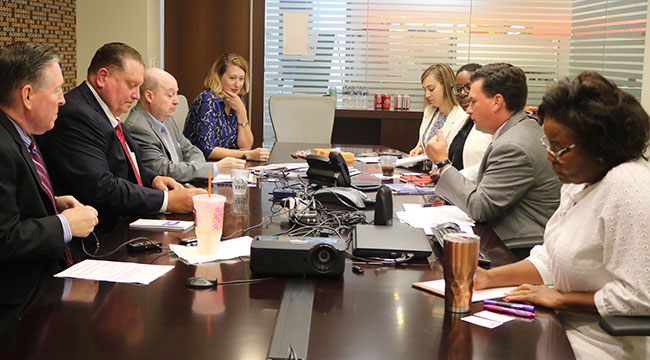
Smith, along with two FedEx Freight staffers, discussed the impact of e-commerce on the trucking industry in a wide-ranging interview with Transport Topics editors and reporters in August. (Marissa Gamache/Transport Topics)
Q: There is talk of a freight slowdown this year. Generally speaking, what signs do you see — good or bad — regarding a freight slowdown? Can you shed light on your outlook for the freight economy now into 2020?
A: We have seen business levels slow, but specifically from an LTL perspective it’s still a good, stable economy here in the U.S. We do feel like there are external factors that will affect that, but right now the market is stable. We feel really good for the upcoming fall.
Q: What do you see in terms of a headcount you’ll need for your growth plans?
A: Overall, we feel really good in the position we’re in. There is a nationwide truck driver shortage, and there’s a nationwide technician shortage. It’s been there for a while, but we haven’t just been sitting around waiting on this to happen. We’ve got several internal programs. Number one, we have a driver apprenticeship program internally where we take folks that do not have a CDL and put them through our own training school. That’s where we get the majority of our new drivers. We will do the same for our e-commerce drivers.
We’ve also changed and developed a new recruiting group within our HR department. We’ve got to get the younger generation who are not going to college and want a good career. We have got to recruit them earlier than we have in the past. There’s some legislation right now that can help all of us in this industry — that can really tie into these high schools from a vocational perspective, as well as the technical schools and the driving schools.
We feel really good both from a driver perspective and a technician perspective because of the things that we’ve done to get ready.
Everyone wants to do everything from their phone. It used to be smaller items …. Now, more and more, they’re feeling more comfortable ordering anything.
John Smith on the rise in popularity of heavy items such as furniture and refrigerators being ordered online
Q: You mentioned the liftgate on trailers. Are you expanding that, and are there other changes to tractors or trailers that you foresee that you’ll need to pursue this e-commerce strategy?
A: We’ve had liftgates in our fleet for years. But when we saw this e-commerce push, we picked up on the speed of transitioning more — both from a trailer perspective as well as our straight trucks. Every straight truck in our fleet has a liftgate, and we have over 4,000 trailers with them. Even though we have never crossed the threshold until we start up with FedEx Freight Direct, we have been doing residential deliveries for years. Today, we deliver 4,000 to 5,000 residential deliveries every day with our existing equipment. But we do not cross the threshold. That’s the difference in what we’re doing today versus what we will be doing in the future to address e-commerce.
One of the biggest things that we have been pushing and backing — there hasn’t been a change to the length of what we call a “pup” — a 28-foot trailer that we run doubles and triples with — since 1982. You’ve seen the 33-foot legislation that we’ve tried to get through over the last 10 to 12 years. We think that’s the No. 1 opportunity that we have because we’re not asking to increase the gross vehicle weight.
From a safety perspective, almost 100% of our linehaul tractors have all the three major safety systems on them. Those are very important and they should be, in our opinion, mandatory — a regulatory requirement.
We have also designed and developed a FedEx Freight Direct straight truck, which is slightly different than what we use business-to-business and what we use in the tighter areas and cities. And we feel really good about that design. We’ve been testing for the last two or three years.
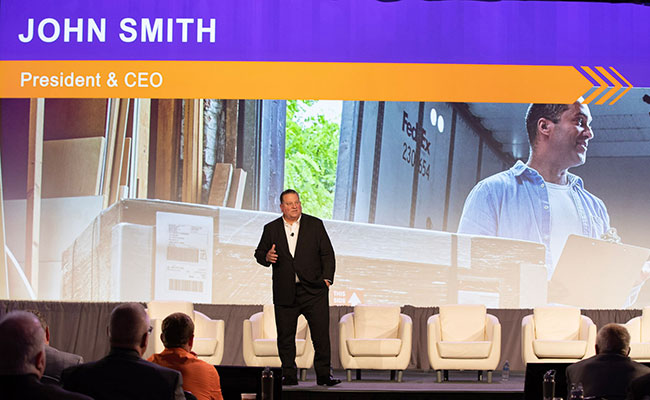
Smith addresses attendees at the FedEx Freight National Leadership Conference in Kansas City, Mo. (FedEx Freight)
Q: Can you expand on what some of those changes might be with the new straight truck?
A: Our first responsibility as an enterprise is safety above all. Everybody is required and expected to be safe.
In order to do that, when you start navigating these residential areas, the height of that vehicle is probably the most critical piece due to the trees, the limbs, the wires — everything else that you’re going to be navigating as you go into these neighborhoods. So what we’ve done is we brought the height of that box down and also shortened the box by 4 feet.
The other big piece with our straight trucks was the turning radius. We have gone to our truck manufacturers and they have come up with a great solution, where these particular straight trucks turn in a radius about one-third less of our original straight trucks. All of them have backup cameras, too. Once we started testing those trucks, our safety record for delivering residential has improved by a ton, so we’re really excited.
Q: As you talk about going across the threshold with these larger items, does that mean a delivery man, like the way a moving company might get this done? Will you partner with other companies? Acquire companies?
A: Our strategy is to put a service out there that, in our opinion, is not available today. That means a FedEx uniformed driver, and an assistant, if needed, with a FedEx truck, on a FedEx freight bill. Completely done with FedEx, with a technology that we feel is going to differentiate us from the marketplace. We feel strong about our brand, our footprint, our network and how this will give several existing and new customers a service they never had before and, in our opinion, an advantage.
Q: One well-known freight carrier just dropped out of the final-mile market. Does that raise any red flags?
A: We have been studying this for quite some time. I can’t speak for folks who’ve been successful or not successful, but we have been watching and studying this market for quite a while. We feel like that the plan that we have come up with and developed will be successful.
Q: Urban delivery and e-commerce are areas that have been highlighted as ones where electrified trucks could and should operate. What are you plans for electrification, even for Class 8? And how about automated technology?
A: With autonomous, we partnered last year with Volvo with test platooning technology, and we feel that’s a critical part going forward with autonomous vehicles. We’re looking at this technology more as an opportunity to enhance safety and efficiencies in our operations. I always like to quote [FedEx Corp. CEO] Fred Smith on this. He said it’s hard to imagine a foreseeable future scenario where automation has largely replaced the need for well-trained pilots and drivers.
As you can imagine, our drivers are very interested in this. I ask them two questions. Number one, how long has it been since we’ve been able to take off and land airplanes without a pilot? Over 30 years. Have you ever been on an airplane without a pilot? I have yet to meet someone that has gotten on an airplane without a pilot. So, do you think you’ll ever be driving down an interstate going 70 miles an hour and a truck passes you without a driver?
But autonomous technology is critical for us, and I think it’s critical for the industry because everything they come up with and develop will make our vehicles safer. That’s why we are so engaged in autonomy.
From an electric perspective, we’re always looking at alternative fuels. We’ve got a facility in Oklahoma City that is run by compressed natural gas, and we have an onsite fueling station there. But we still feel like, from an alternative fuel, that electrification is the future. With straight trucks, if we can get 120 to 150 miles out of these vehicles on a daily basis, that fits into the duty cycle that we run. And the battery technology just continues to improve. Look at it 10 years ago versus where we are today — it is exponentially getting better and better. And we are on the list to test some Tesla trucks as soon as they can deliver them to us. We really are very interested in the electrification of all of our vehicles.
There is a way to go, in my mind, on longhaul, but with the city equipment and the shorthaul captive vehicles, we definitely have an opportunity to electrify.
Q: What is the role of government, federal or state, in helping to bring about electrification? Should there be mandates, incentives, grants? Should there be more than there are now?
A: There are some, but we’d like to see more of them. I believe it’s more for the manufacturer to drive that than the trucking folks, even though we’re going to be the ones testing them — giving them feedback, helping with design and going through the specs with them. But any time you get any kind of government subsidy to test those vehicles, we look at it very thoroughly. We’ve done them in the past and have some going on today. But my opinion may not be everyone else’s opinion as how I feel about electrification versus comparing it to natural gas. Some folks think it should be natural gas. So we’ll see.
Want more news? Listen to today's daily briefing:

